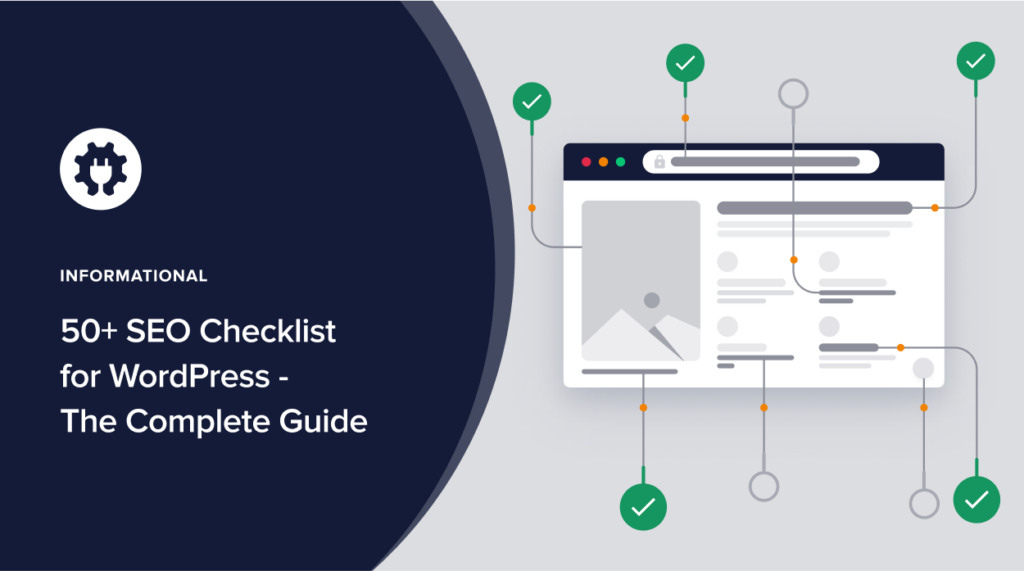Looking for a comprehensive SEO checklist to help you rank well?
Search engine optimization (SEO) can be quite overwhelming because of the many moving pieces involved in creating an impactful SEO strategy.
In this article, we’ll show you 50+ SEO requirements you need to tick off your task list as you prep your website and content for success on search engine results pages (SERPs).
In This Article
- What is SEO?
- How to Use This SEO Checklist
- SEO Tools Checklist
- Keyword Research Checklist
- On-page SEO Checklist
- 10. Nail Your Headline
- 11. Include Your Keyword in the SEO Title
- 12. Ensure Your Keyword is in Your Subheadings
- 13. Use Your Keyword in the First and Last Paragraphs
- 14. Include Your Keyword in the Meta Description
- 15. Customize Your URLs to Include Your Keyword
- 16. Use Your Keyword Strategically in Your Content
- 17. Build Internal Links Strategically
- 18. Build Strategic Outbound Links
- 19. Build Topic Clusters
- 20. Implement Google E-E-A-T
- 21. Use as Many Header Tags as Necessary
- 22. Craft Compelling Meta Descriptions
- 23. Don’t Forget Tags and Categories
- 24. Image SEO Still Carries Some Weight
- 25. Ensure You’re Not Using Interstitial Ads
- Off-page SEO Checklist
- 26. Evaluate Your Backlink Profile
- 27. Check Your Competitors’ Backlink Profiles
- 28. Build Relevant Backlinks
- 29. Leverage Guest Posting
- 30. Generate Conversations Around Your Brand
- 31. Turn Mentions into Backlinks
- 32. Are You Using Barnacle SEO?
- 33. Use PR to Boost SEO
- 34. Create a Free Tool and Use it as a Link Magnet
- Technical SEO Checklist
- 35. Identify Crawl Errors
- 36. Check for Indexing Issues
- 37. Fix Broken Links on Your Site
- 38. Implement HTTPS via an SSL Certificate
- 39. Use SEO-friendly URLs
- 40. Ensure Your Website is Responsive
- 41. Optimize for Speed
- 42. Inspect Your Website for Redirect Chains and Loops
- 43. Generate an XML Sitemap
- 44. Fix any Duplicate Content Issues
- 45. Create/Optimize Your Robots.txt File
- Content Creation Checklist
- 46. Conduct a Content Gap Analysis
- 47. Does Your Content Solve a Problem?
- 48. Work on Your Posts' Readability
- 49. Craft Optimized Headlines
- 50. Create High-quality In-depth Content
- 51. Implement Schema Markup
- 52. Write Engaging Intros
- 53. Use Multimedia to Increase Engagement
- 54. Publish Content Regularly
- 55. Keep an Eye on Your Analytics
- Get a Head Start with this SEO Checklist
What is SEO?
SEO stands for Search Engine Optimization. It refers to the practice of optimizing your site and web pages to improve their visibility on search engines like Google. SEO aims to enhance a website’s organic (non-paid) search engine rankings for relevant keywords. This involves various strategies and techniques, including:
- Keyword Research: Identifying and targeting relevant keywords that users might search for.
- On-Page Optimization: Optimizing content, meta tags, and HTML elements on individual pages to make them more search engine-friendly.
- Off-Page Optimization: This involves strategies like building external links to your site from reputable sources to improve its authority and credibility.
- Technical SEO: Addressing technical aspects of your site, such as site speed, mobile-friendliness, and crawlability, to ensure search engines can easily index and rank it.
- Content Creation: Producing high-quality, relevant, and valuable content that attracts and engages the target audience.
- User Experience (UX): Ensuring that the website provides a positive and seamless experience for visitors.
SEO is crucial for businesses and individuals looking to increase their online visibility, drive organic traffic, and ultimately achieve better rankings in search engine results pages (SERPs). However, because this digital marketing disciple has so many moving parts, it’s best to have a comprehensive SEO checklist to help ensure you cover all the bases.
How to Use This SEO Checklist
To help you get the most out of this SEO checklist, we’ve broken it down into the main sections that cover the main principles of SEO, mainly:
- SEO Tools Checklist
- Keyword Research Checklist
- On-page SEO Checklist
- Off-page SEO Checklist
- Technical SEO Checklist
- Content Creation Checklist
Feel free to go straight to the section most pertinent to you so you can implement the strategies you need ASAP!
So, let’s dive right into our SEO checklist and get your WordPress site to rank higher on SERPs.
SEO Tools Checklist
Before we dive into our SEO checklist, let’s quickly go over some SEO tools you’ll need to have in your toolbox. These are tools you can use to plan, design and implement your SEO campaigns.
1. AIOSEO
One of the first SEO tools you need is a WordPress SEO plugin. While there are many plugins that can help you with SEO, you’d want to stick to the original and best plugin. And that’s All In One SEO (AIOSEO).
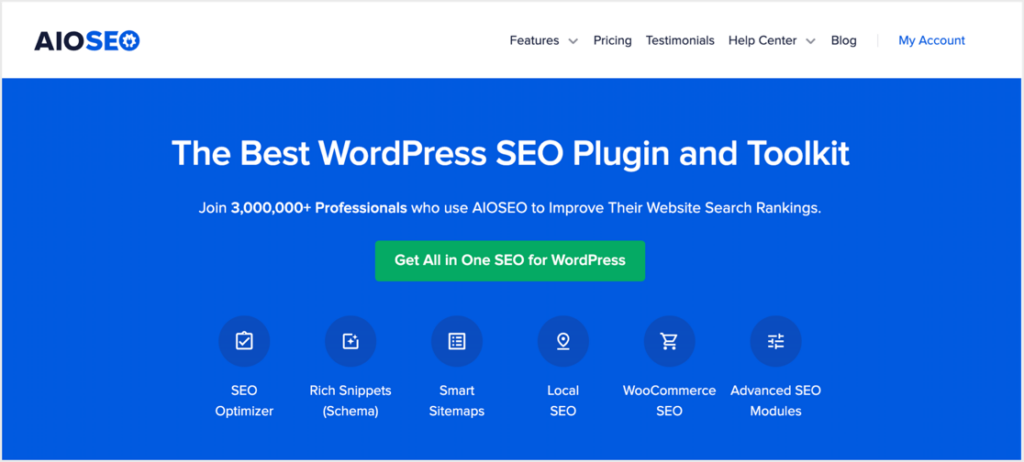
- Cornerstone Content: Easily build topic clusters and enhance your topical authority and semantic SEO strategy.
- Search Statistics: This powerful Google Search Console integration lets you track your keyword rankings and see important SEO metrics with 1-click, and more.
- SEO Revisions: Track any changes you make to your site and see their impact on your SEO. Plus, you get to see on a timeline how Google updates affect your site.
- Advanced Robots.txt Generator: Easily generate and customize your robots.txt file for better crawling and indexing.
- TruSEO Highlighter: Makes it easy to spot on-page SEO issues and gives recommendations for fixing them.
- Next-gen Schema generator: This no-code schema generator enables users to generate and output any schema markup on your site.
- Redirection Manager: Helps you manage redirects and eliminate 404 errors, making it easier for search engines to crawl and index your site.
- Link Assistant: Powerful internal linking tool that automates building links between pages on your site. It also gives you an audit of outbound links.
- SEO Preview: This gives you an overview of your search and social snippets and general SEO so you can improve your optimization.
- IndexNow: For fast indexing on search engines that support the IndexNow protocol (like Bing and Yandex).
- Sitemap generator: Automatically generate different types of sitemaps to notify all search engines of any updates on your site.
- And more.
AIOSEO also has many other features to help you boost your local SEO, on-page SEO, and technical SEO. Plus, if you’re a WooCommerce user, AIOSEO has a tailor-made WooCommerce SEO module to help you rank your online store higher in search rankings.
For step-by-step instructions on how to install AIOSEO, check our detailed installation guide.
AIOSEO = No Code SEO
One of the most significant factors that make AIOSEO one of the most popular WordPress SEO tools (according to 3 million users) is that it’s a no-code tool. It makes it easy to implement SEO best practices, even if you’re not technically inclined.
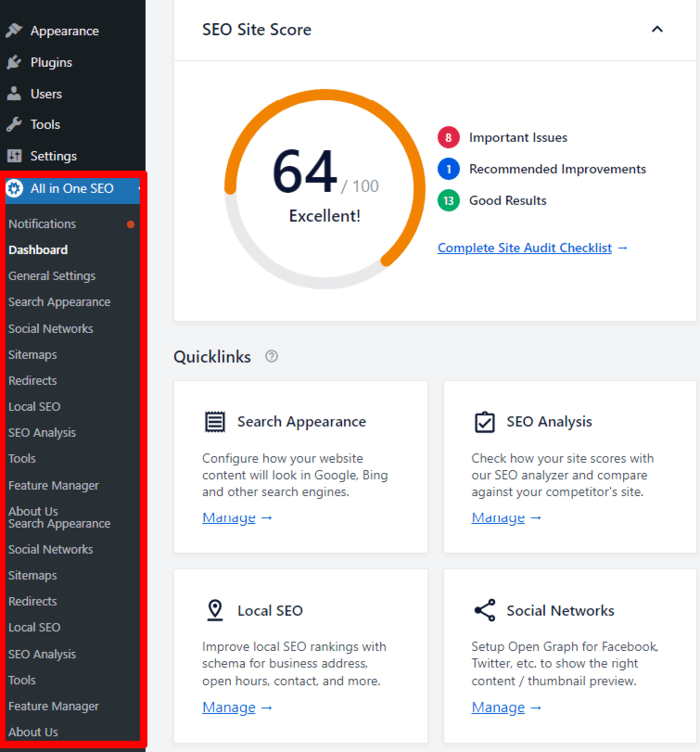
What can you do with AIOSEO?
Here’s a preview:
- Manage internal and external links using Link Assistant
- Create sitemaps
- Implement schema markup
- Manage redirects easily
- Edit robots.txt files
- Optimize for on-page SEO
- Implement breadcrumbs
- Create SEO-friendly URLs
- IndexNow for instant indexing on select search engines
There’s so much you can do with AIOSEO. It’s the only WordPress SEO tool you’ll ever need.
Pricing: Paid plans start at $49.65. A free plan is also available.
2. Google Search Console
Another tool you need to add to your SEO tool stack is Google Search Console (GSC). FYI, Google is the largest search engine and processes over 3.5 billion searches per day. Investing more on optimizing for this platform is a no-brainer.
GSC is a free tool from Google designed to help web admins track their site’s performance in Google search results.

It has useful statistical data and features that help you rank better. In addition, Google Search Console helps you identify issues that hinder your website’s performance. Examples of what GSC can help you with include:
- Keyword analysis
- Submitting your sitemap
- Fixing website errors
- Checking your page experience scores
If you haven’t yet, go ahead and set up your Google Search Console. It will help you power your SEO campaigns with relevant data and insights.
You can also use AIOSEO’s GSC integration, Search Statistics to get data on your SEO performance.
Pricing: Free.
3. Google Analytics
Another free tool from Google you need to add to your toolbox is Google Analytics (GA).

Is there a difference between GSC and GA?
There certainly is. While Google Search Console focuses on the performance of your website, Google Analytics was designed to give you insight into audience behavior.
The insights you get from analyzing audience behavior are important as they help you understand what your target audience needs from you. As a result, you can build tailored campaigns that ensure you attract the right traffic. It also helps improve your conversion rates. Some uses of GA include:
- Measure the traffic you get from Google
- Identify the pages that bring the most traffic
- Check if traffic increases or decreases before, during, and after SEO campaigns
- Identify websites and other platforms that send you traffic
- Monitor critical metrics like bounce rate, page views, time on site, and more.
GA is an invaluable resource you should definitely have. What’s more, you can connect it to GSC for more in-depth and rich data, all from your GA dashboard.
Pricing: Free.
4. MonsterInsights

MonsterInsights is the best WordPress Google Analytics plugin on the market. The plugin gives you essential insights into how visitors interact with your site. You can track where they’ve come from and their behavior. This gives you vital information into what your visitors want and how you can best optimize your site and content for maximum conversions.
In short, MonsterInsights gives you all the power of Google Analytics on your WordPress site but with an easier dashboard to use.
And if you run an online store built using WooCommerce or Easy Digital Downloads (EDD), MonsterInsights also offers enhanced eCommerce tracking features. These help you optimize your site and landing pages for improved sales.
Pricing: Starts at $99.50/year. A free version is also available.
5. Bing Webmaster Tools
While Bing may not be the biggest search engine (that honor belongs to Google), it still has a massive user base. With over 1.3 billion visitors each month, it certainly deserves your attention. To optimize for this group, you must set up Bing Webmaster Tools to help you.
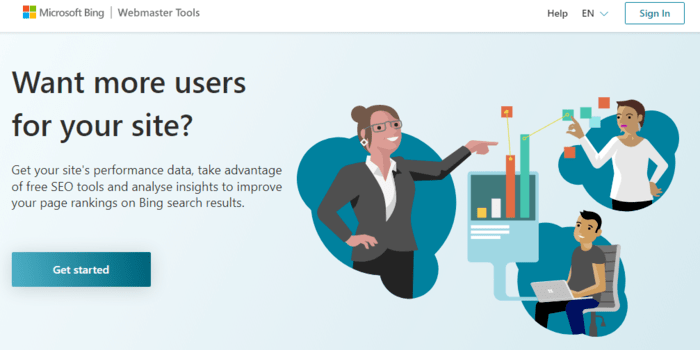
A few features of Bing webmaster tools include:
- Track search performance (on Bing, of course)
- Upload sitemaps
- Site scan
- Keyword research
- Submit URLs
- Control crawling and block URLs
Pricing: Free.
With all these tools at your disposal, ticking off some tasks on your SEO checklist becomes much easier. You can easily scale your SEO strategy without breaking a sweat.
Keyword Research Checklist
One of the foundational pillars of SEO is keyword research. Most on-page SEO efforts hinge on it. Here are some essentials you must get right to ensure you have better chances of ranking:
6. Invest in a Good Keyword Research Tool
Keywords are still relevant and will continue to be. Without them, SEO ranking wouldn’t exist. That’s why you must invest in a good keyword research tool. Examples of some excellent ones include:
Many more keyword research tools are on the market, but you can’t go wrong with these.
7. Focus on Long-tail Keywords
Long-tail keywords are keywords that feature two or more words. These usually have lower competition, convert better, and are more targeted, among other benefits. Easy ways of finding long-tail keywords include:
- Google’s auto-suggest feature
- Blog comments, especially questions
- Answer the Public
- Forums
Besides these, long-tail keywords are also an excellent way to rank one piece of content for many keywords. Plus, they have an added advantage of having lower keyword difficulty scores.
8. Focus on Search Intent (User Intent)
As you conduct your keyword research, make sure to include search intent (the reason for the search) in the equation. Understanding search intent helps you:
- Create content that users find valuable
- Drive quality traffic to your website
- Improves the quality of your leads
- Results in higher conversion rates
- Reduces bounce rates
Neglecting search intent will cripple your SEO efforts. As such, put in the extra effort and time to dig deeper as you do your keyword research.
9. Leverage Question-based Keywords
Most search queries are made in the form of a question. Leveraging question-based keywords will help you:
- Create content that meets user intent
- Rank for Google’s SERP features like featured snippets
- Help rank in voice search
As much as you can and where applicable, find question-based keywords and answer the question comprehensively in your content.
On-page SEO Checklist
Now that keyword research is done, we can move on to the on-page SEO factors you must get right.
10. Nail Your Headline
One of the first things people see when looking for content online is the headline. It’s your first shot (and usually the only shot) to convince readers to delve deeper into your content.
That’s why you must ensure every headline you write is expertly crafted. It must:
- Encourage readers to click through
- Contain your keyword, preferably at the beginning
- Satisfy user intent
- Be short enough not to be truncated on SERPs
- Long enough to prove the value of your content
To craft the perfect headline, you must try out several iterations and test to see which is more effective. Thankfully, our Headline Analyzer can help you with this.
11. Include Your Keyword in the SEO Title
One of the most important places to include your keyword is in your SEO title. This is the title search engines use to display your post on SERPs. Therefore, make sure to include your keyword in the SEO title, preferably as close to the beginning as possible. This will help users and search engines quickly know what your post is about.
If you’re an AIOSEO user, this is super easy to do. All you have to do is head over to your post settings and add it under the “Post Title” section.

12. Ensure Your Keyword is in Your Subheadings
Your subheadings, or heading tags, play a critical role in on-page SEO. They help structure your content and give search engines context about the central message of your page. That’s why you must use your keyword and its synonyms in your heading tags.
13. Use Your Keyword in the First and Last Paragraphs
Search engines put more weight on your page’s first and last paragraphs because these usually sum up what the post is about. To help them, include your keyword in these two critical sections of your post.
14. Include Your Keyword in the Meta Description
Your meta description is a summary that describes your post. Including your keyword helps search engines know that your post is relevant to display for the search term. It also helps users determine if your post will answer their questions.
15. Customize Your URLs to Include Your Keyword
WordPress assigns default URLs to all pages and posts. Always customize your URLs to make them descriptive. Also, ensure your URL includes your keyword. Doing so helps boost your SEO and clickthrough rates.
16. Use Your Keyword Strategically in Your Content
Use your keywords naturally in your content, and avoid keyword stuffing. To avoid keyword stuffing, use synonyms of your keyword.
17. Build Internal Links Strategically
Internal links play a crucial role in SEO because they help search engines better understand your website structure and the relationship between pages. Internal links also help users get more value from your content as they point them to other pages with more context.
- To build a strategic internal linking strategy:
- Decide on the ideal structure of your website
- Determine which pages are the most important
- Prioritize linking to high-value pages
We get it. Building internal links, especially when you’ve got hundreds of pages, can be quite taxing. That’s why we decided to develop a tool to help you effortlessly do so. It’s called Link Assistant, and you’ll find it in the Feature Manager section of our plugin.
Link Assistant offers internal linking suggestions and automatically adds the links you choose without opening the individual pages.
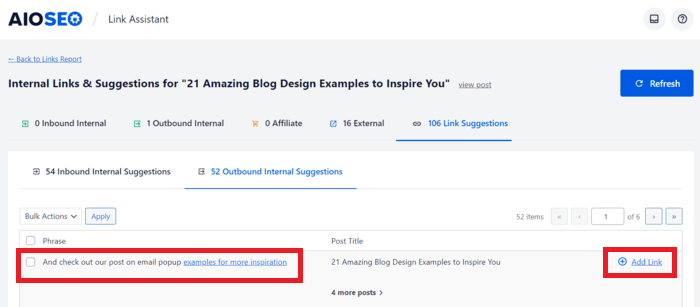
Building internal links has never been easier.
18. Build Strategic Outbound Links
Outbound links are links that point from your domain to another domain. They are great for giving more context to your content. They’re also a great way of building authority. To build outbound links effectively:
- Only link out to authoritative sites
- Link to recent content (no older than three years)
- Only link when it makes sense
- Ensure your outbound link opens in a new tab
Again, Link Assistant is an invaluable tool in this regard. It gives you an overview of all your outbound links and enables you to edit them easily.
19. Build Topic Clusters
Topic clusters are a group of relevant content pieces that comprehensively cover a subject from many angles and are interlinked. They help build topical authority and enhance your semantic SEO, both great ways of getting your site and content to rank in a competitive niche.
Creating a topic cluster requires 2 main components:
- Cornerstone content (pillar page): The pillar page is the hub of the topic cluster. This page covers the main subject in-depth, with each subheading briefly addressing related subtopics.
- Subtopic pages: Subtopic pages are the pieces of content you create to provide in-depth coverage of a single aspect of the main subject and link to the pillar page.
Once you’ve built your pillar pages and subtopics, create strategic internal links between them. This can be automated by using AIOSEO’s Link Assistant module.
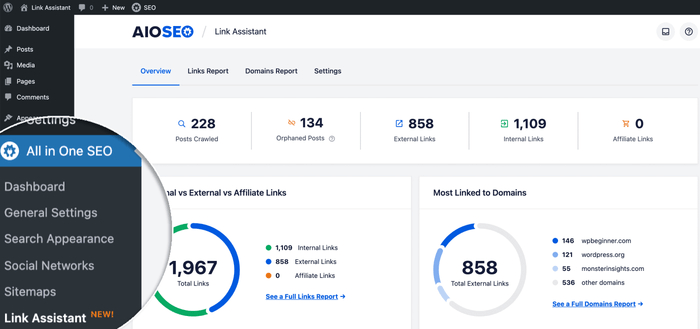
If you’re not using this in your content strategy yet, you’re missing out on an opportunity to rank for multiple keywords and topics.
Building topic clusters is one of the WordPress SEO tips you should implement religiously, as it has the potential to help you outrank your competitors.
20. Implement Google E-E-A-T
Google’s E-E-A-T stands for Expertise, Experience, Authoritativeness, and Trustworthiness. It is a set of standards Google uses to assess the quality of content on the web. It especially impacts YMYL (your money, your life) pages. These are topics that require the utmost accuracy and reliability as they can drastically influence the reader’s life. Examples of YMYL topics include health and finance.
Implementing Google’s E-E-A-T content quality guidelines is easier if you have a plugin like AIOSEO. This is thanks to the Author SEO module.

This module enables you to add information to your user profiles:
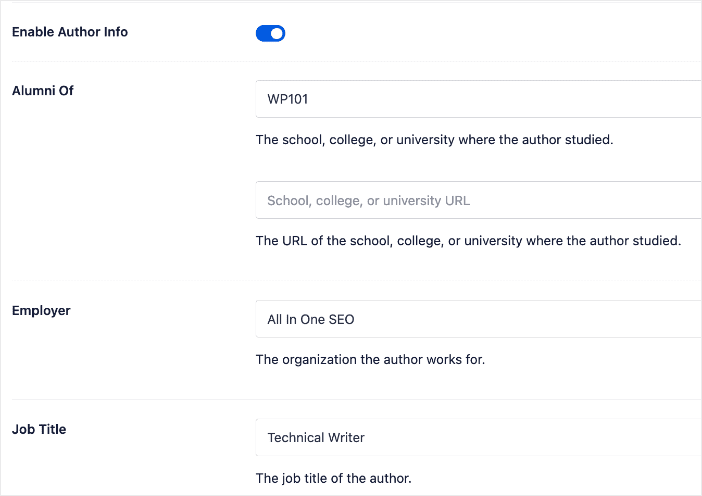
Besides general author info, you can also add your areas of expertise:
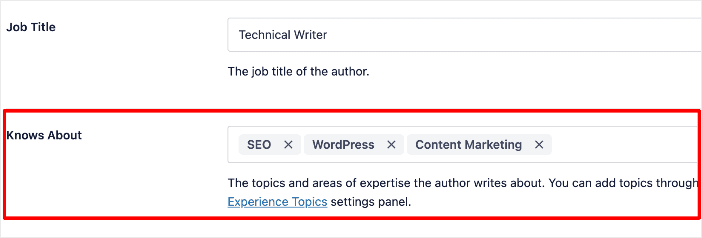
All this information points to your experience and expertise in your field. It also helps enhance your authority and trustworthiness. Coupled with the JSON schema markup, it proves to search engines that you’re qualified to talk about the subject. This helps you rank higher in searches around your keyword.
21. Use as Many Header Tags as Necessary
Header tags are HTML tags used to structure a webpage and indicate the hierarchical importance of the sections of a page. Headers rank in order of importance, starting with the H1 tag (the title) to H6, which is the least important. Besides adding structure to your web pages, header tags also:
- Give search engines more context as to what your page is about
- Improve the readability of your page
- Offer a great opportunity to use your keywords strategically
Header tags are an important element of your page that, used wisely, can help boost your SEO. For example, best practice dictates that there be no more than 300 words between each header tag.
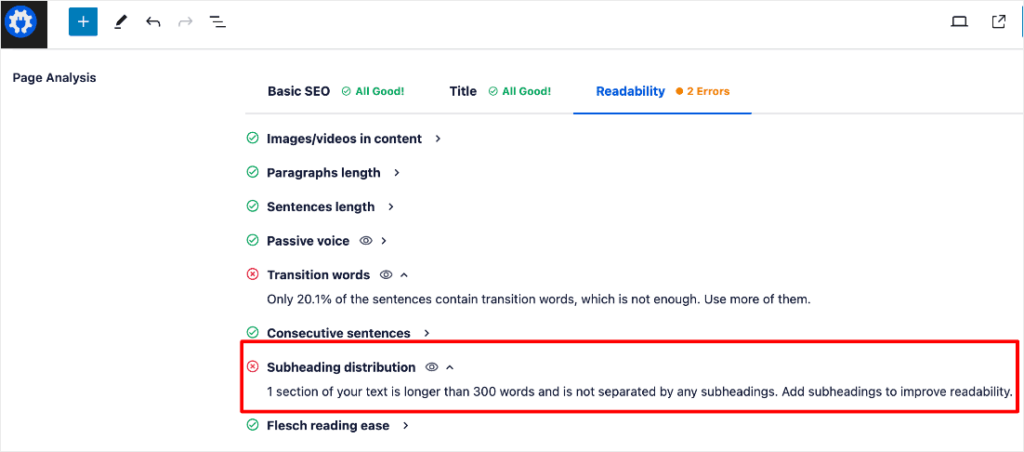
22. Craft Compelling Meta Descriptions
A meta description is a short blurb or summary that appears underneath your page’s title on the SERPs. Its purpose is to provide users with an overview of the content to expect on that particular page. To craft compelling meta descriptions:
- Include your keyword
- Be as descriptive as possible
- Keep it within 160 characters
With the limited space you have available, you must ensure that your meta description does an excellent job selling your content.
Check out our tutorial on creating meta descriptions that boost your rankings for more information.
23. Don’t Forget Tags and Categories
Tags and categories are often overlooked when working on on-page optimization. Check out this article for an in-depth look at what tags and categories are and how they differ.
In short, however, tags and categories offer a way to help you group similar content. This makes it easier for users to find content on your website. On the SEO side of things, they also help search engines better understand what your page is about.
If you’re prone to forgetting to assign tags and categories to your content, you probably need a tool like AIOSEO. We include tags and categories in our pre-publish checklist.
24. Image SEO Still Carries Some Weight
Images play an essential role in readability and add to your content’s aesthetics. But more than making your posts look pretty, images also contribute to your SEO. Here are a few image SEO tips:
- Resize your images as images with large dimensions load slower
- Compress images to make the file size “lighter”
- Add alt tags to all images, ensuring to include your keyword
- Name your images descriptively
Image SEO aids in ensuring your pages load faster. It also helps provide users with a good experience, while helping you convey your message better.
25. Ensure You’re Not Using Interstitial Ads
Interstitial ads are interactive, full-screen ads that cover their host app or site’s interface. Because of this, they reduce a web page’s accessibility.
Some key characteristics of interstitial ads include:
- Full-screen: They take over the entire screen, grabbing the user’s full attention.
- High impact: Their prominence makes them hard to miss, potentially leading to higher engagement and click-through rates.
- Disruptive: While effective, they can interrupt the user experience if not implemented strategically.
- Variety of formats: They can come in various formats, including static images, videos, GIFs, and interactive elements.
While they’re helpful, interstitial ads should be used strategically, as Google penalizes websites that use them in a way that goes against their page experience guidelines.
Off-page SEO Checklist
Off-page SEO refers to the activities that take place away from your website and yet impact your SEO. Here are a few to include in your SEO checklist so you rank higher:
26. Evaluate Your Backlink Profile
Backlinks are one of the core elements that give weight to off-page SEO. Before you start building them, first evaluate your backlink profile. This will help you better plan your link-building strategy. To check your backlink profile, you can use tools like Google Search Console, Ahrefs Backlink Checker, Screaming Frog, and more.
27. Check Your Competitors’ Backlink Profiles
Besides checking your backlink profile, you should also do the same for your competitors. Competitor analysis serves two purposes:
- It gives you an idea of the strength of your backlink profile
- It shows you potential sites to get backlinks from
Start by checking the backlink profiles of your direct competitors, then move on to indirect competitors who rank for the same keywords as you do.
28. Build Relevant Backlinks
With the foundation laid, you can now start building backlinks to your site. A few ways you can do this include:
- Fixing broken links
- Run outreach campaigns
- Find backlink opportunities from your and your competitors’ top referrers
- Participate in roundup posts
- Create link-worthy content (original reports are an excellent example)
For more tips and strategies for building backlinks, check out this guide from our friends over at Monster Insights.
29. Leverage Guest Posting
Guest posting is the practice of publishing content on sites that are not yours. It serves a two-fold purpose:
- Helps build your authority
- Earns you backlinks from the sites you publish on
Guest posting also has the added advantage of helping you tap into new audiences. You generate relevant traffic from the host sites. For it to work, however, you must ensure you target websites with similar audiences to yours. You must also create value-packed content that the readers will find helpful.
30. Generate Conversations Around Your Brand
Backlinks aren’t the only way to get search engines to notice you. When your brand is mentioned on other websites or platforms like social media, search engines also pay notice.

Sometimes called linkless backlinks, these mentions are trust signals that add to your credibility and authority. A few ways to boost mentions of your brand include:
- Be active on social media
- Don’t shy away from controversial issues
- Monitor mentions of your brand and participate in the conversations
- Have a reputation management plan in place to combat negative mentions
The more buzz you can build around your brand, the more search engines view you as an authority. As a result, your rankings will improve.
31. Turn Mentions into Backlinks
While most mentions of your brand are linkless, it shouldn’t always end that way. Instead, you should try to turn mentions of your brand into backlinks. To do so, reach out to the publication that mentioned you and ask them to include a link back to your website in the mention. Since they already know you, they’re more likely to respond positively.
32. Are You Using Barnacle SEO?
Barnacle SEO is a strategy in which a smaller website attaches itself to a larger website that ranks well. For this strategy to work, the larger website must rank for keywords you’re targeting. A great example of barnacle SEO is leveraging business directories and listings. For example, if you’re a B2B brand, you can find ways of being featured on partner pages and review sites like G2.
33. Use PR to Boost SEO
Public relations (PR) campaigns are another SEO practice you should apply regularly. You don’t always need breaking-news level stories to run a PR campaign. Simply leverage any changes in your organization, like new hires, a new office, e.t.c to write about. Other PR strategies that can help you boost your SEO include:
- Regularly publish in industry-centric or local publications
- Book speaking engagements
Often an overlooked strategy, PR can be a powerful tactic to help you boost your SEO.
34. Create a Free Tool and Use it as a Link Magnet
One of the best ways to earn backlinks is by creating a free tool your target audience finds valuable. This can be something as simple as a spreadsheet or a more complicated tool like a niche-specific calculator. Other publishers will link to the page your tool is on to help add value to their posts, resulting in you earning tons of backlinks.
Technical SEO Checklist
For most marketers and website owners, the mention of technical SEO sends shivers down their spine. That’s because most see it as a difficult task they’d rather not dabble in. But with a powerful SEO plugin like AIOSEO, sorting out your technical SEO issues becomes a breeze. Here are some technical SEO areas you must always keep an eye on
35. Identify Crawl Errors
Crawling is the process search engines go through to discover and understand the content on your website. Sometimes, this process can be hindered, resulting in some of your pages not showing up on SERPs.
To identify crawl errors, check your Coverage report in Google Search Console. Make sure to fix any crawl errors you find ASAP.
36. Check for Indexing Issues
While crawling is the discovering process, indexing is the process by which search engines collect, sort, and store information of pages on your website. This facilitates fast retrieval of your URLs. Common indexing errors include:
- Duplicate content
- Soft 404 errors
- Redirects
- Crawl issues
- Insufficient crawl budget (for large sites)
Again, you can use Google Search Console’s Coverage report for this. You can also use Ahrefs’ Site Audit tool to generate an Indexability report.
If you’re an AIOSEO user, you can easily check if your content has been indexed using the built-in Index Status tool.
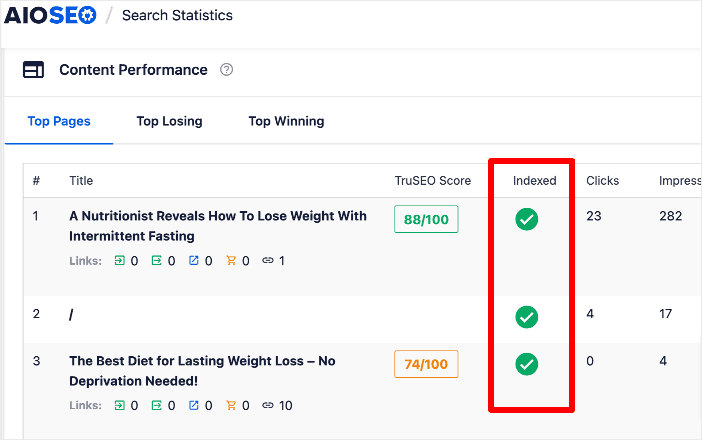
This helps you identify indexing issues much faster.
37. Fix Broken Links on Your Site
Broken links frustrate your visitors. They can also hurt your SEO.
That’s why you must find and fix all broken links on your site.
There are two primary types of broken links you’ll encounter on your website — external and internal.
The way you deal with your broken links is dependent on which type you find. A few common ways of fixing broken links include:
- Deleting the link (for external links)
- Applying a 301 redirect (for internal links)
- Updating old content
- In the case of a typo, correcting it
You can use a tool like Google Search Console to find broken links. You can also go the easier route and use AIOSEO’s Broken Link Checker.
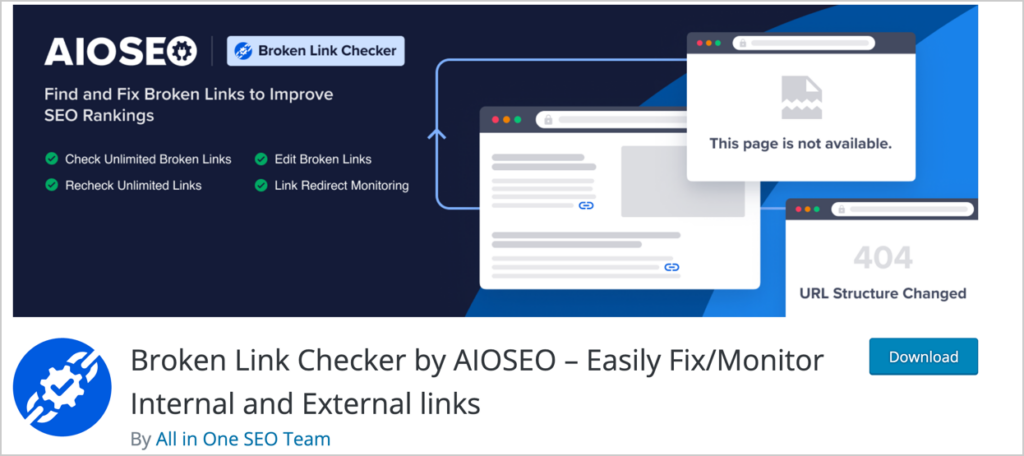
This powerful tool automatically finds and fixes broken links on your site, making it easy for you to tick this item off your SEO checklist.
38. Implement HTTPS via an SSL Certificate
Have you switched to HTTPS?
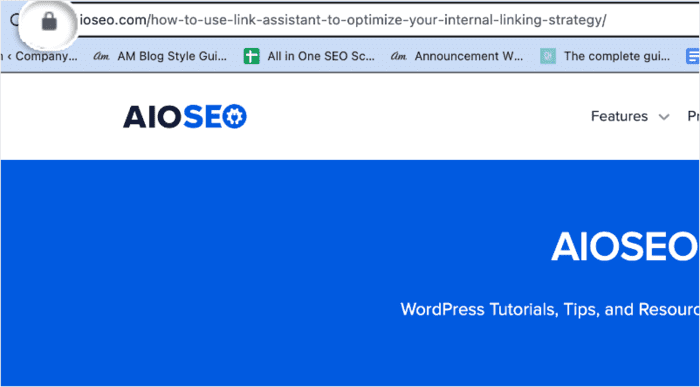
Or are you still using the less secure HTTP protocol?
Google confirmed in a publication that HTTPS is a “lightweight” ranking factor, so you shouldn’t take it lightly.
Besides being a ranking factor, implementing HTTPS is also good for your users as it improves your website’s security. It also helps you earn your audience’s trust, as it shows that you take website security seriously.
Check out our guide on the benefits of HTTPS for SEO.
39. Use SEO-friendly URLs
URL structure plays a critical role in your SEO. That’s why you must take time to ensure that all your URLs are structured in an SEO-friendly manner. Tips for doing so include:
- Keep your URLs short and descriptive
- Include your keyword in permalinks
- Use hyphens (not underscores) to separate words
- Get rid of stop words
- Use lowercase letters
To optimize your URL, edit your URL slug under the post settings section.
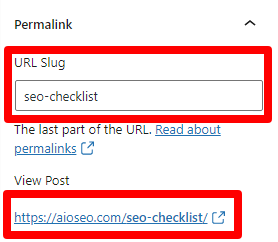
Good URL structure helps your SEO and makes for good UX.
40. Ensure Your Website is Responsive
While the song’s been sung many times, it still needs to be put on repeat — mobile responsiveness is a key element of good SEO. With most searches being performed on mobile devices, having a mobile-friendly website is a no-brainer. You can use Google’s Mobile-Friendly Test tool to test for any issues that can affect your site’s responsiveness.
41. Optimize for Speed
Page speed has been a ranking factor for a long time (from as far back as 2010). With Google’s Page Experience in effect, page speed has become more crucial than ever. Use a tool like PageSpeed Insights to check how your website fares in this department and other factors that affect Core Web Vitals.

You also get suggestions on the recommended steps to take to improve your speed.
For more tips, check out our tips on improving site speed.
42. Inspect Your Website for Redirect Chains and Loops
A redirect happens when you forward one URL to another. Therefore, a redirect chain happens when there are many redirects between the initially requested URL and the destination URL. In some cases, this can turn into a redirect loop. That happens when the last URL in the chain redirects to the original URL.
- Redirect chains and loops can hurt your SEO as they can:
- Make it harder for your website to crawl
- Reduce your page load speed
- Cause you to lose page rank
- Lead to poor UX
Again, AIOSEO can help you fix redirect chains and loops through the Redirection Manager feature.
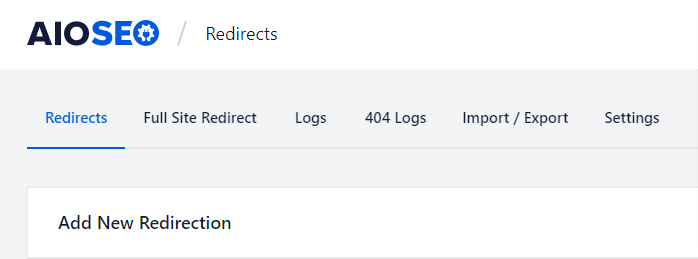
43. Generate an XML Sitemap
An XML sitemap is a file containing all the important pages on your website. Its purpose is to ensure that search engines can easily find and crawl them. It also includes information on any changes in your content. A sitemap also helps search engines understand your website’s structure.

One of the most significant SEO advantages of an XML sitemap is that it makes it easier for search engines to crawl and index your most important pages. It also helps ensure search engines can find the orphan pages on your site.
Thankfully, setting up an XML sitemap is easy if you have an SEO tool like AIOSEO. Here’s our detailed guide on creating XML sitemaps in WordPress.
44. Fix any Duplicate Content Issues
Duplicate content is any content on your website that’s exactly or nearly the same. This can be a common problem on e-commerce websites as some product pages can be almost identical. One of the best tools you can use to find duplicate content is Ahrefs. Head over to “Site Audit” and select the “Duplicate Content” option. This will show you all pages that are considered to be duplicate content.
Once you’ve identified duplicate content on your site, you can canonicalize the affected URLs as you deem fit.
45. Create/Optimize Your Robots.txt File
A robots.txt file is a file that contains instructions that tell search engines which pages they can and can’t crawl. This ensures that search engines focus on pages that are important to you. It also prevents server overload and prevents crawl waste for large websites.
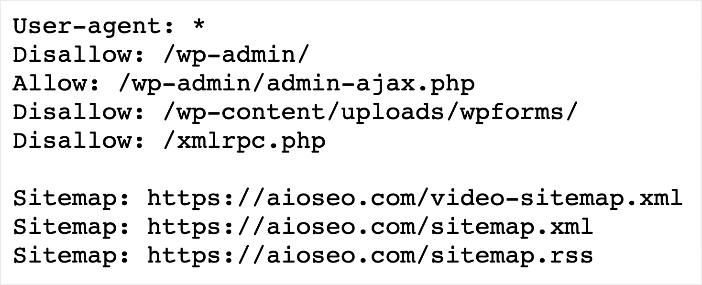
Creating or optimizing your robots.txt file can easily be done using AIOSEO’s Robots.txt Editor. Simply head over to the “Tools” tab in AIOSEO and you’ll be taken to the robots.txt file editor.
Here are some instructions on how to edit your robots.txt file.
Content Creation Checklist
While we have touched on on-page SEO best practices in a previous section, we must also look at best practices for effective blog post SEO. After all, SEO and content are two sides of the same coin.
46. Conduct a Content Gap Analysis
A content gap analysis is a process of assessing your content to discover opportunities you’re missing out on. It helps you identify missing content pieces you could use to align users to the stages of your buyer journey. A content gap analysis enables you to create content that, among other things:
- Increases audiences engagement
- Drives more traffic
- Meets user intent
Conducting a content gap analysis is a great way to ensure you create content that both search engines and users love. So make sure this tip is included in your SEO checklist.
47. Does Your Content Solve a Problem?
Creating content that solves a problem is critical to an effective SEO content strategy. Otherwise, you won’t get any traffic to your site if it doesn’t. If you get any visitors, the chances of bouncing are quite high. Creating problem-solving content starts with keyword research and understanding search intent. It also involves:
- Audience research to understand who you’re writing for
- SERP research to discover the content formats your audience prefers
- Competitor research to find high-ranking content
People are fed up with superficial content that just scratches the surface. They‘re looking for content that solves a problem and helps them reach their goals. Give it to them, and they’ll share it with their networks, resulting in more traffic to your website.
48. Work on Your Posts’ Readability
Another SEO element to get right as you create your content is readability. Create content that’s easy to scan and understand. A few ways to achieve this include:
- Avoid passive voice
- Keep your sentences short
- Avoid walls of text (each paragraph must be 300 words max)
Easy-to-read text results in more engagement, increased time on the page, and more page views. All of these are indicators to search engines that your content is valuable and worth ranking higher.
Again, AIOSEO can help you improve your readability as our TruSEO analysis gives you a readability score and recommendations for improving it.

Check out our tutorial on improving your readability score for more details.
49. Craft Optimized Headlines
Your headline is different from your SEO title. While the SEO title is displayed in SERPs, the headline, or H1 tag, is only displayed on the page. Like your SEO title, optimize your headline by front-loading your keyword. Also, make sure it’s as descriptive as possible.
While this may seem like a trivial element, including it in your SEO checklist will help you get better SEO performance and results.
50. Create High-quality In-depth Content
Before hitting the publish button on any blog post, ensure you’ve covered the topic as in-depth as you can.
Gone are the days when you could drive traffic and rank from thin content. Today’s users and search engines are too advanced to be hooked by flaky content. To hook them, you must create high-quality content that covers the topic.
Check out some of our recommended content optimization tools that can help you create high-quality SEO-friendly content.
51. Implement Schema Markup
Schema markup or structured data is a type of microdata used to describe a page’s contents to search engines. Implementing it results in more descriptive and visually appealing rich snippets on SERPs.

Implementing schema is super-easy with a tool like AIOSEO, as you don’t need to touch a single line of code.
We’ve created an in-depth tutorial on implementing schema markup in WordPress. Check it out so you tick this item off your SEO checklist.
52. Write Engaging Intros
Your introduction is an opportunity to hook readers and convince them to read on. Poorly written, it results in high bounce rates, which are bad for SEO. On the other hand, engaging intros result in readers spending more time on your site. That’s great for SEO as it signals search engines that your content is valuable.
53. Use Multimedia to Increase Engagement
The more people engage with your content, the more search engines consider it worth serving to users. This is why you must include multimedia in your content. It increases the engagement rates of your content. That’s because people love images, gifs, videos, and any other type of visual content. Multimedia content also gives you a chance to utilize your keywords, as you can inject them into your alt tags.
54. Publish Content Regularly
Search engines love websites that are updated regularly. This signals that they are a resource of timely and relevant content. That’s why you must publish content regularly. To help you do this, create a content calendar that will help direct your content creation and keep you regular in your publishing.
55. Keep an Eye on Your Analytics
To know if you’re meeting your SEO goals, you need to monitor your performance. That’s why keeping your eye on your analytics is crucial. Thankfully, you can do that right from within your WordPress using AIOSEO’s Search Statistics module.
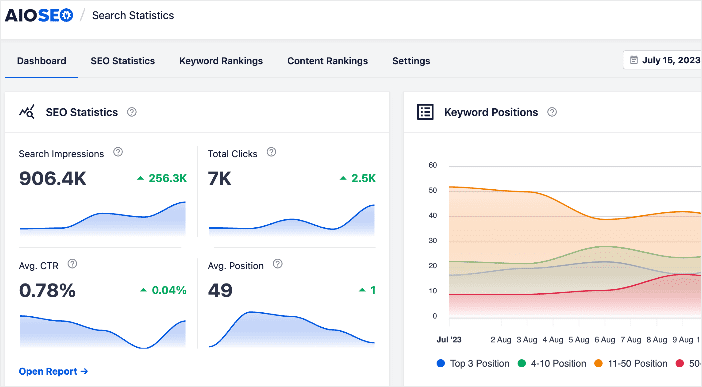
For step-by-step directions, check out our tutorial on monitoring your SEO performance in WordPress.
You can also use a Google Analytics tool like MonsterInsights, or others to keep track of your SEO performance. This will help you know if you’re making headway or not. It will also help you know what to improve to build better iterations of your SEO campaigns. These are definitely great tools to help ensure you get the most mileage out of your SEO checklist.
Download A Free SEO Checklist
Access our comprehensive SEO Checklist with a single click. We’ll deliver it straight to you, putting actionable items with SEO tools and tutorials right at your fingertips.
Enter your name and email to download a free SEO checklist.

Get a Head Start with this SEO Checklist
SEO is an ever-evolving discipline. While this post may not contain everything required to optimize your WordPress website for search engines and people, this SEO checklist will certainly give you a great head start. Go ahead and make the changes you need to in your SEO strategy and website.
We hope this post has helped you know the top WordPress SEO tips you can implement on your site. You may also want to check out other articles on our blog, like our guide to common SEO mistakes to avoid or our tutorial on using HTML tags for SEO.
If you found this article helpful, then please subscribe to our YouTube Channel. You’ll find many more helpful tutorials there. You can also follow us on Twitter, LinkedIn, or Facebook to stay in the loop.
Disclosure: Our content is reader-supported. This means if you click on some of our links, then we may earn a commission. We only recommend products that we believe will add value to our readers.
